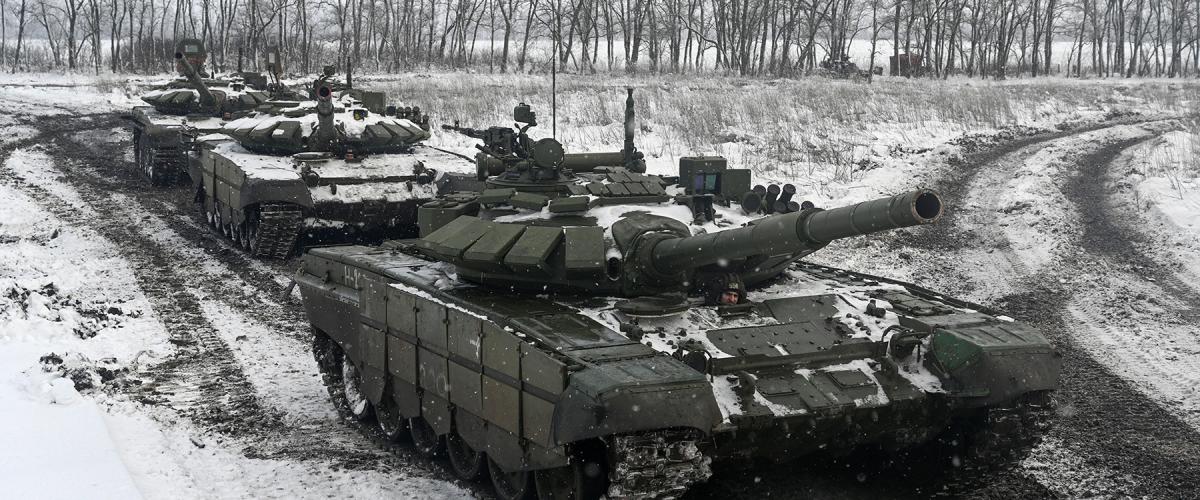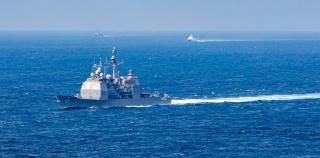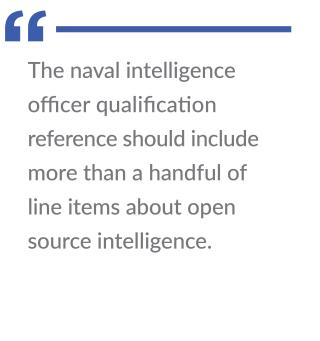Ensign Nick Danby

Russia’s invasion of another sovereign nation should have come as a shock. But because of timely, accessible, and accurate warnings about Russian troops massing at Ukraine’s borders, the world was braced for the onslaught. That Russia—a “strategic competitor”—has been unable to overcome a humiliating stalemate against an ill-equipped Ukraine also should have been surprising, if not for allied intelligence warning and sharing and Ukraine’s agile, guerrilla-ized targeting of Russia’s offensive military vulnerabilities.
U.S. and allied intelligence professionals must study the lessons of the war in Ukraine to hone their skills and dominate the next conceivable fight: China’s forceful reunification of Taiwan.
The shared strategic contours between Ukraine and Taiwan make this policy analogy compelling. In both instances, a “great power” is hell-bent on forcing a former “territory” back under its control while Washington and other Western capitals attempt to thwart capitulation.
Serving as part of the carrier strike group intelligence staff on board the forward-deployed USS Ronald Reagan (CVN-76), I have studied the lessons of Ukraine from afar and applied them to a festering conflict in the Indo-Pacific. It is important to note, however, that Taiwan is not Ukraine, and the situation in Ukraine does not presage Taiwan’s future. Differences include:
• The United States recognizes Ukraine as a sovereign nation but not Taiwan. The 1979 Taiwan Relations Act, however, binds Washington to support Taiwan’s “self-defense”; no such agreement exists with Ukraine.1
• Ukraine shares a land border with Russia. A 100-nautical-mile-wide strait separates Taiwan from China. Invading Taiwan will not be as easy as rolling tanks and troops across the Ukrainian border.
• Taiwan is the poster child for prosperous liberal democracies, ranking eighth in the Economist Intelligence Unit’s Democracy Index. Ukraine ranks 87th (below Mexico and above Senegal).2
• Taiwan is an interconnected, global trading hub, exporting six times as many goods as Ukraine. The global supply chain is also dependent on Taiwan’s advanced semiconductor industry.3
• China’s People’s Liberation Army (PLA) has spent the past decade fielding a modernized and capable suite of platforms and weapons. To the contrary, some Russian military equipment is thrice the age of its operators or simply inoperable.4 Nonetheless, Russian forces faced combat in Chechnya, Georgia, and Syria over the past two decades. China has not waged war in 43 years.
On balance, these distinctions suggest Taiwan could withstand an invasion more skillfully and successfully than Ukraine. What’s more, the war in Ukraine has proven that Washington and its allies can resist China’s revanchist aims toward Taiwan through an aggressive, two-stage intelligence strategy. First, intelligence professionals must know the battlespace by observing and studying the adversary’s tactics, techniques, and procedures (TTPs) and pattern of life to warn of an imminent invasion. Thereafter, they can own the battlespace by rapidly and widely disseminating warning intelligence and targeting the enemy’s vulnerabilities. In short, intelligence officials must prepare commanders for conflict and help them dominate that conflict.
Warn Early and Often
Naval intelligence professionals consider themselves to be “jacks of all trades.” Doctrine has not contradicted this belief. According to Naval Warfare Publication 2, Naval Intelligence, naval intelligence should “provide insights into this uncertain world,” assess situations, forecast adversary courses of actions, and discriminate between friendly and hostile forces.5 Buried deep within this list of responsibilities is intelligence’s most important function: delivering indications and warnings (I&W) that provide a commander with the time to make informed decisions that protect the force and frustrate the adversary. An absence of warning intelligence invites geostrategic fiascoes (e.g., Pearl Harbor, the 1979 Iranian Revolution, the 1962 Cuban Missile Crisis, and the 11 September attacks).
In late 2021, the U.S. intelligence community (IC) led from the front by analyzing the massing of Russian troops on the Ukrainian border, predicting Vladimir Putin’s plan to invade Ukraine, and warning the rest of the world before Russian tanks rolled onto Ukrainian soil in February 2022.6 The margin for miscalculation was thin. Intelligence professionals had to determine whether Moscow was posturing for a major military exercise or preparing for war. Thankfully, the IC had spent more than a decade observing both Russian invasions and exercises. Analysts knew how to scour the battlespace, looking for certain indicators that historically portended war.7
The IC, and particularly naval intelligence, might not have that advantage if China unleashes an amphibious invasion or naval blockade of Taiwan. Beijing has not waged war in more than four decades.8 No analytical baseline exists to differentiate a Chinese exercise from an invasion. This means the U.S. IC could fail to forewarn of a Chinese invasion or mistake an exercise for an invasion or vice versa. Improving confidence in these assessments starts with reinvigorating maritime operational intelligence (OpIntel) with analytical discipline and original thought.

The USS Chancellorsville (CG-62) transits the Taiwan Strait near PLAN ships. Intelligence analysts can begin to predict China’s actions by observing how it responds to such actions. Did the PLAN dispatch surface units to shadow the warship? How many? How long? How close? By plotting enough of these “points,” naval intelligence professionals can develop baselines, charts, and heat maps that document standard PLA behavior. U.S. Navy (Justin Stack)
Spot the Difference
OpIntel in today’s U.S. Navy is a shell of its former self. Once defined as “the art of providing near-real-time information concerning the location, activity, and likely intentions of potential adversaries,” it has been watered down to moving small pucks on a PowerPoint slide with lukewarm and languid assessments about the adversary’s intentions and movements.9 OpIntel can—and should be—much more.
At its best, OpIntel asks three questions. Where is the enemy? What is the enemy doing? What is the enemy going to do? Accurate responses require knowledge of the adversary’s actions, aims, behaviors, and trends. How can an analyst predict what China will do if he or she has no clue what it has done? For example, when an Arleigh Burke–class destroyer sails through the Taiwan Strait, how has the PLA historically responded? Do PLA Air Force aircraft overfly the destroyer? If so, how many, what type, from which airbase, and what is their closest point of approach? Does the PLA Navy dispatch surface units to shadow the warship? How many? How long? How close? What are the capabilities of the shadowing units? By plotting enough of these “points,” naval intelligence professionals can develop historic baselines, charts, and heat maps that document standard PLA behavior. They also can spot training patterns that reveal the PLA’s plans for fighting the next war.
In addition, identifying or predicting the “unprecedented” that could precede an invasion demands independent research and out-of-the-box assessments that stretch analysts’ imaginations and understanding of an adversary’s options. Military intelligence tends to force “groupthink” on its analysts. The Naval Intelligence Officer Basic Course, for example, places a higher premium on platform recognition, rote memorization, and PowerPoint-ology than on crafting original assessments about the adversary.10 Most of the time, students’ assessments are loosely pulled from another agency or command.
In military intelligence, unlike the rest of the world, plagiarism is not taboo. That should stop. To paraphrase General George Patton, If everyone is assessing alike, then somebody isn’t assessing.11 Commands and agencies tapped into the “China problem” need to study the problem, arrive at individual conclusions, and independently “war game” a forceful reunification of Taiwan to determine probable indicators of conflict. It is challenging for analysts to accurately predict an invasion without knowing what one looks like.
Last, and most important, assessing an adversary’s intent for war warrants an academic interest in the adversary’s leaders, national interests, military doctrine, history, culture, technological advancements, and language that forces intelligence professionals to think “Red.” Hours before the Russian invasion of Ukraine, top French and Ukrainian intelligence officials still believed Putin was bluffing.”12 They reasoned the “juice wasn’t worth the squeeze” for Putin because he could achieve similar goals without incurring the costs of an invasion. By operating in a “Blue” headspace, these analysts could not fathom that Putin viewed Ukraine’s burgeoning relations with the West as an attack on Russia’s version of history, which is “an inextricable part of Russian national identity.”13 The adversary does not think like us. Why should we?
‘Intel, Intel, Read All About It’
By understanding the PLA’s TTPs and pattern of life and the assessed differences between its peacetime training and wartime preparations, the IC can exploit an all-source fusion intelligence process to trip conflict indicators, rapidly answer the commander’s critical information requirements, and control the conflict’s narrative.
Too often, the IC inadvertently embraces analytical stove-piping. The National Geospatial-Intelligence Agency or imagery intelligence specialists will ground their assessments in geospatial intelligence. The National Security Agency or cryptologic warfare personnel rely on signals intelligence. The list goes on; this segregation is dangerous. A Navy intelligence specialist can be a trained imagery intelligence analyst, but that does not mean he should overlook other types of intelligence.
Naval intelligence’s modus operandi has been superior battlespace awareness (through a rigorous OpIntel process) and I&W to the commander. Intelligence personnel can provide both if they develop that battlespace baseline and deduce multisource intelligence and accurate assessments faster than the enemy when that baseline shifts. As the late Captain Wayne Hughes explained in his definitive work Fleet Tactics and Naval Operations: “Scouting always has been an important constant of war: winners have out-scouted the enemy in detection, in tracking, and in targeting.”14
In Ukraine, U.S. and allied intelligence agencies delivered comprehensive, correct, and swift I&W by exploiting open source intelligence at a level comparable with other, more established intelligence sources. The payoff?
• Intelligence on the cheap. By mid-October 2021, social media and media outlets began reporting significant Russian military movement near Ukraine’s border and inside Crimea based on firsthand accounts and commercial satellite imagery.15 Instead of drafting assessments based on highly technical, expensive, and classified sensors, analysts evaluated the situation by sourcing openly accessible and free information across the internet.
• Expedited allied sharing and public dissemination. With commercial imagery companies posting near-real-time images of Russia’s military movements, TikTok users sharing videos of Russian military equipment, and news agencies reporting battlefield updates, the IC was able to swiftly share assessments (based on open source intelligence) to partner nations and the public.16 To quote one IC spokesperson: “The intelligence community surged personnel and resources to support classification reviews for increased intelligence sharing . . . and declassified reviews for potential release to the public,” which open source intelligence made easier.17
• Forearming our friends. The IC’s decision to widely publish assessments about Russia’s planned invasion allowed decision-makers enough time to begin training, equipping, and recruiting Ukrainians to defend their homeland while developing a Western coalition of the willing to support Ukraine.
• Thwarting our adversaries. A month before the Russian invasion, U.S. intelligence officials warned that Russia would use false-flag incidents as a pretense for war. If the international community had remained in the dark, Moscow would have argued that it invaded Ukraine to protect Russia’s “homeland security.” Open source intelligence not only disproved Russia’s false-flag stunts, but also enabled the world to see Russia’s invasion for what it was: premeditated.18

The ability to push more comprehensive assessments to more people in less time validates open source intelligence’s importance in the next fight. Of course, you get what you pay for. The surfeit of available open source materials (and their potential for error or bias) prior to the Russian invasion underscores the need for public-private partnerships to develop machine learning to process and parse credible open source materials.
At my command, I compile daily “open source intelligence reviews” for senior leaders. In more than a handful of instances, electronic intelligence analysts reported ship movements that we did not quite understand until a foreign newspaper article explained the ship’s mission. Bottom line: fusing all information sources yields a more complete battlespace.
Other commands should follow suit by analyzing open-source information. But to do that, the Navy needs to develop best practices, training guides, and more open-source-focused applications on classified servers. For starters, the naval intelligence officer qualification reference should include more than a handful of line items about open source intelligence, especially when other intelligence sources fill pages.
Owning the Battlespace
Once the naval intelligence team warns the commander, they can help the commander dominate the fight by identifying the adversary’s centers of gravity and asymmetrically targeting their critical vulnerabilities.
A key Russian center of gravity is the aging but battle-tested offensive military equipment it uses to prosecute its wars.19 That same hardware is also a critical vulnerability. Russia can defeat a foe with overwhelming firepower from its Slava-class cruisers, MiG-29 fighters, or T-90 tanks, but if a foe neutralizes all this equipment, it neuters Russia’s military capability. Enter Ukraine.
Ukraine has not—and cannot—match Russia ship for ship, tank for tank. It has instead chosen to wage an asymmetric war: sinking the Russian Navy’s flagship, shooting helicopters from the sky, and exploding tanks with antiplatform weapons.20 The Ukrainians discovered they do not need a billion-dollar warship to destroy Russian capital ships when a sea mine or antiship missile will do the trick at a fraction of the cost.21
Naval intelligence should ask what critical vulnerabilities China will face if it invades Taiwan. The room for error and operational fiascoes is certainly higher than Russia rolling tanks into Ukraine. Because China likely would invade Taiwan with amphibious and airborne personnel, intelligence officials should ask which amphibious vessels or transport aircraft would carry out the invasion and which would be most vulnerable to Taiwanese antiship cruise missiles or antiaircraft weaponry. If China’s three Yushen-class amphibious assault ships are transiting the Taiwan Strait, destined for an amphibious invasion on Taiwan’s coast, at what point are these ships most vulnerable?
Beyond determining what and when to strike, intelligence professionals will need to guerrilla-ize the fires process by simplifying the kill chain. Moving away from long-range constructive kills on an adversary’s warship with an F/A-18E/F Super Hornet and embracing dynamic, mobile simulated strikes on an adversary’s landing craft with a ground-based, antiplatform weapon (e.g., a rocket launcher or drone) is a good place to start. Vastly different targeting mechanisms warrant a vastly different find, fix, track, and target process.
At the end of China’s intense, eight-day military exercise around Taiwan following Speaker Nancy Pelosi’s visit in August 2022, China promised “regular patrols” in the future.22 Such exercises will be an intelligence windfall. U.S. naval vessels can observe China’s vulnerabilities and their overreliance on a supporting unit or platform when simulating an invasion. If the PLA is going to tip its hand, the U.S. military should not look the other way.
A Legacy to Protect
At its core, intelligence should drive operations—and victory. Predictive, accessible, and accurate intelligence in Ukraine demonstrated the community’s value. Commanders of future conflicts will require acute battlespace awareness that rationalizes and anticipates the adversary’s movements while targeting vulnerabilities.
If commanders doubt what they require of their intelligence team, they should heed Admiral Chester Nimitz’s instruction to his intelligence officer, Edwin Layton, after Pearl Harbor: “You are to see the war, their operations, their aims, from the [enemy’s] viewpoint and keep me advised what you are thinking about, what you are doing, and what purpose, what strategy, motivates your operations.” Nimitz told Layton that if he did all that, “you will give me the kind of information needed to win this war.”23 Today’s commanders should expect no less of their intelligence teams.
No comments:
Post a Comment